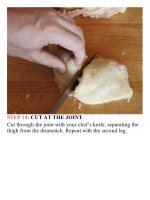The food lab better home cooking through science ( PDFDrive ) 116
Bạn đang xem bản rút gọn của tài liệu. Xem và tải ngay bản đầy đủ của tài liệu tại đây (194.92 KB, 2 trang )
POACHEDEGGS
What would eggs Benedict be without perfect soft-poached
eggs, their snowy whites napped in a robe of gloriously
thick, buttery real hollandaise and liquid, golden yolks
ready to ooze out over your ham and into the nooks and
cranniesofyourbutteredandtoastedEnglishmuffin?
Well, we already know all about soft-boiled eggs, and a
poached egg is essentially a soft-boiled egg cooked in the
nude (that’s the egg, not the cook). This does, of course,
introduce all kinds of headaches. How does one keep the
white from spreading in the pot of water? How do you
preventtheyolkfrombreaking?Howdoyougetthewhole
darn thing to keep its shape? Some recommend wrapping
eggsinplasticwrapbeforeloweringthemintothewater,to
help them retain their shape. The eggs end up with ugly,
creased surfaces. Other high-tech methods require hourslong baths in perfectly temperature-controlled water to
partially solidify the eggs, to help them keep their shape
whilepoaching.I’mnotpreparedtowakeupanextrahour
earlyjusttopoachmyeggs.
But take a look at your poached egg problems, then ask
yourselfacoupleofquestions.Whendoyourpoachedeggs
work? That answer is easy: when the eggs are fresh. The
olderanegggets,theweakerthemembranethatsurrounds
the white becomes, and the more likely it is that your egg
will spread when it hits the water.This leads us to our first
ruleofpoachedeggs:useveryfresheggs.
What exacerbates the possibility of the white falling
apart? Agitation. The more the egg shakes and shimmies,
the more likely it is it’ll separate. It’s standard practice to
poach eggs in simmering water, but we already know that
eggs will coagulate even at a subsimmer, so there’s no
reasontokeepthewateranywherenearaboil.Bringitupto
aboil,thenturntheheatoffwhenyouaddtheeggs.
Butwhatifyou’vegotfresheggsandasubsimmeringpot









